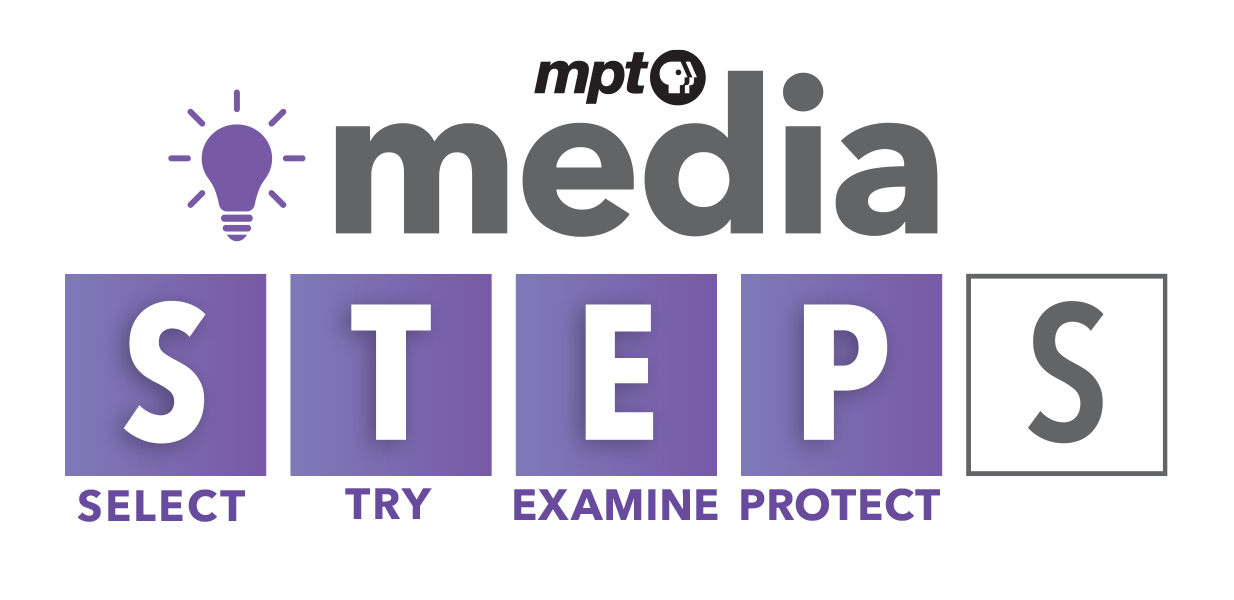AI Literacy STEPs for Families

Artificial intelligence (AI) is rapidly transforming the way we live, work, and connect with the world around us. From everyday tools like voice assistants and smart search engines to breakthroughs in healthcare, business, and creative industries, AI is becoming an increasingly powerful part of daily life.
AI literacy expands media literacy for the modern age—helping people of all ages understand not just the messages in media, but the intelligent systems that now help make and deliver them. But understanding how AI works and how it affects our choices is important for everyone in the family. AI literacy helps adults and children alike recognize how these technologies shape what we see and do, think critically about the information AI provides, and use it responsibly and ethically.
The following resources are designed to help families explore AI — learning what it is, how it’s used, associated risks and responsibility, and how we can all stay informed and empowered in the age of AI.

Select which AI tools are right for your family.
Read each tool’s age restrictions and explore parental control features to determine which AI tools and uses are appropriate for your family members.

Try a variety of different AI tools.
Talk with your kids about what tools they use or explore an AI resource together. Becoming familiar with what AI can do can help you develop AI guidelines for the members of your family.

Examine the results of AI.
AI can make mistakes. Talk with your kids about the importance of questioning AI results and identifying potential inaccuracies, biases, and misinformation.

Protect personal information.
Have conversations with your family about the information they can share on AI platforms and opt into privacy settings that provide protections for your family’s data.
AI FAQ
View our FAQ page to find answers to common questions about artificial intelligence (AI).
⮞ Go to Frequently Asked Questions about AI
Featured Resources
This section provides resources for parents learning to navigate AI tools with their families.Understanding AI
Before exploring a specific AI tool's capabilities, it's helpful to first understand how AI works at a basic level. The following resources provide simple-to-understand explanations of often complex AI concepts as well as family resources for learning AI literacy skills.
Internet Matters | Guide to AI Tools
Learn more about what AI is and how it works. This guide explains AI concepts in plain language and provides children’s safety recommendations for popular AI tools like ChatGPT and Snapchat's AI.
Audience: Families
Format: Article, Interactive Guide
PBS Crash Course AI | What is Artificial Intelligence?
Watch this introductory video from PBS’s Crash Courses series on artificial intelligence to learn more about what AI is and how it works. This video explains the basics of how AI systems work and dispels common myths surrounding the technology. It also traces the history of AI.
Audience: Families, Educators, Tweens & Teens
Format: Video
MSDE | AI Hub
Explore a curated collection of resources that explore the impact of AI on children's development and provide advice for discussing the technology with kids.
Audience: Families, Educators
Format: Articles, Glossaries, Online Modules, Lesson Plans
Common Sense Media | Parents' Ultimate Guide to Generative AI
Learn more about the risks and benefits of teenagers using generative AI tools. This article provides useful definitions for common AI terms and provides tips for helping teens develop healthy AI habits.
Audience: Families
Formats: Article
AI for Education | What Parents and Caregivers Should Know
Help your family navigate our increasingly AI-mediated world. This guide suggests resources, activities, and strategies for building AI literacy skills at home and guidelines for advocating for responsible AI policies at school.
Audience: Families
Formats: Guide (PDF)
BBC | Five things you really need to know about AI
Discover the history of AI and the mechanics that make the technology work – or fail to work. This video discusses five facts about AI: 1) AI is as old as your grandparents, 2) AI can't feel or think, 3) AI makes stuff up, 4) AI can sound racist and sexist, 5) AI has incredible potential.
Audience: Families, Educators, Tweens & Teens
Format: Video
Recognizing AI Risks
Tools that generate text, images, music, and video blur the line between human- and machine-made information. Media-literate users need AI literacy to question what’s authentic, identify misinformation or “deepfakes,” and understand how AI-generated content is produced.
PBS Crash Course AI | Algorithmic Bias and Fairness
Learn more about the biases that affect the AI tools that you use. This video introduces the concept of algorithmic bias, explains why this kind of bias occurs, and discusses what’s at stake when these biases are left unchecked in our increasingly algorithm-driven world.
Audience: Families, Educators, Tweens & Teens
Formats: Video
Britannica Education | Spotting AI: Knowing How to Recognise Real vs AI Images
Test your ability to spot AI with Britannica Education’s interactive quiz and learn helpful techniques for spotting AI-generated images.
Audience: Families, Educators, Tweens & Teens
Format: Article, Interactive Quiz
NPR | 4 tips for spotting deepfakes and other AI-generated images
Develop strategies for identifying AI-generated visuals and deepfakes online. This Life Kit article discusses how AI images can be used to spread misinformation and offers the SIFT method – Stop, Investigate the source, Find better coverage, Trace the original source – as a tool for safeguarding against deceptive content.
Audience: Families, Educators
Formats: Article
James O'Hagan | What We Talk About When We Talk to Our Kids About AI
Understand how inequality shows up in AI systems you use. This article discusses how AI technologies can amplify bias and offers tips for talking about these biases with children. It also provides advice for parents advocating for responsible AI policy use in schools.
Audience: Families, Educators
Format: Article
MIT Media Lab| Gender Shades — Joy Buolamwini
In this video, researcher Joy Buolamwini talks about bias in AI image recognition technology. Learn more about how AI tools reflect harmful biases and what's at stake when the AI systems that increasingly power our world are discriminatory.
Audience: Families, Educators
Formats: Videos
Responsible Use and Safety
Just as media literacy teaches ethical sharing and digital citizenship, AI literacy encourages responsible engagement—understanding the impacts of using AI tools and protecting privacy.
Common Sense Media | Teaching Kids to Protect Their Data and Privacy Online
Discover ways to help protect your kids’ personal data online. This article contains tips for creating strong and secure passwords, turning on child protection features, and avoiding sharing personal information online.
Audience: Families, Educators
Formats: Article
APA | Four ways parents can help teens use AI safely
Explore ways to help keep your teens safe while using AI. This article explores the challenges AI technologies present for teens and suggests concrete actions parents can take to safeguard their teens experience with these tools. The article also provides tips for identifying AI platforms with strong data protections.
Audience: Families, Educators
Format: Article
Parent Coalition for Student Privacy | Five Principles to Protect Student Privacy
The Parent Coalition for Student Privacy is an advocacy group fighting for stronger student data protections online. This article sets out five principles for developing safer AI at the state and school level: transparency, non commercial uses, parental/student rights, and enforcement. The website also contains helpful resources discussing the importance of student data protections.
Audience: Families
Format: Articles, Blogs, Toolkits, Searchable Resources
Common Sense Media | AI Risk Assessments
Common Sense Media's AI Risk Assessment is a fairly comprehensive, yet easily digestible breakdown of popular AI tools. The assessment describes what each tool does, how it works, its benefits and risks, as well as the tool's limitations. It also grades tools on a risk scale according to Common Sense's 8 AI Principles, which includes criteria like a tool's bias, transparency, fairness and, perhaps most relevant to this element of the STEPS framework, Kids & Teens' safety. You can read Common Sense's AI and Our Kids for more a more detailed description about their assessment considerations.
Audience: Families, Educators
Format: Article
